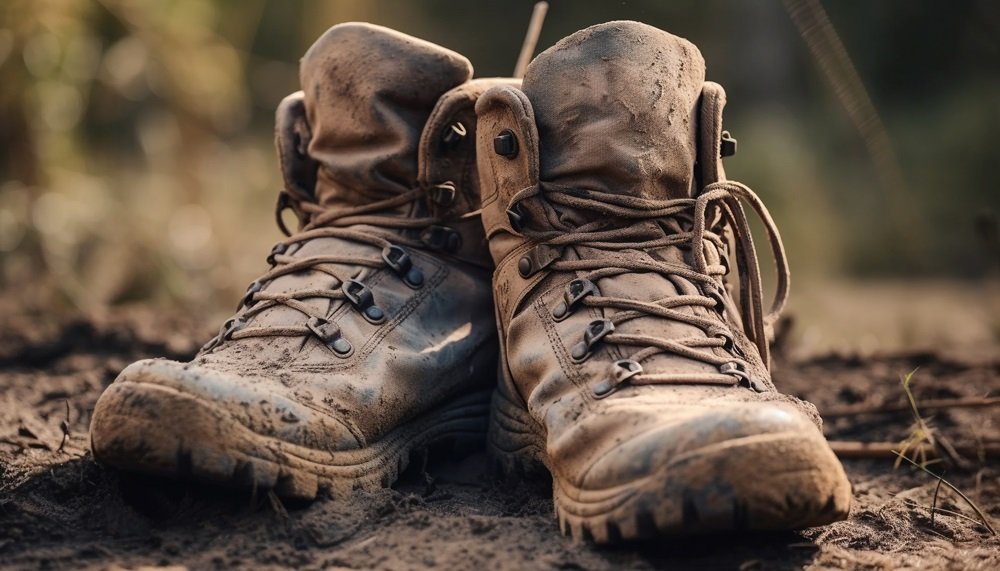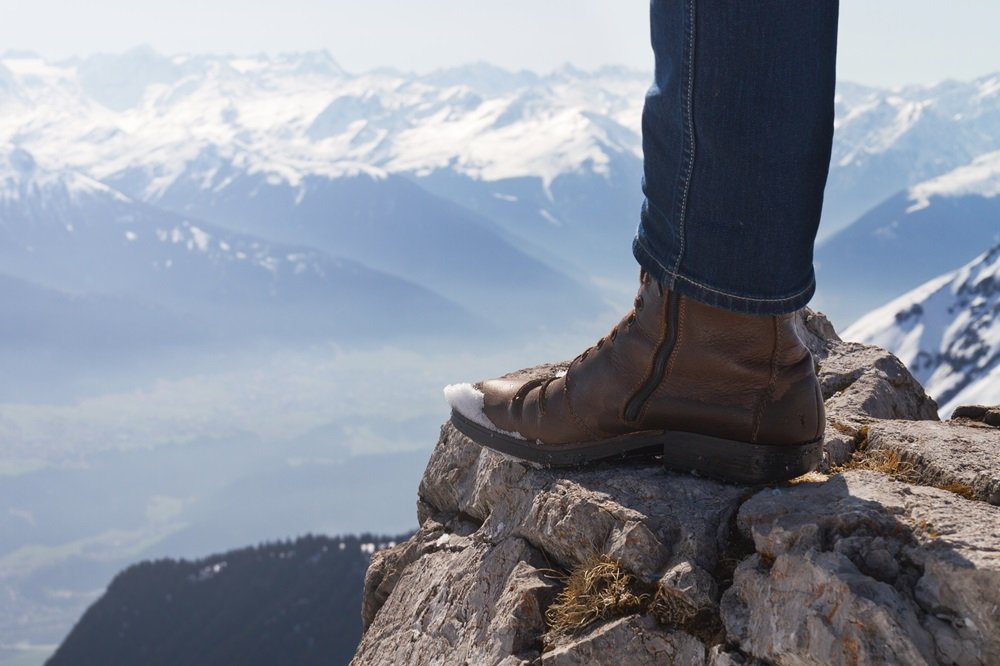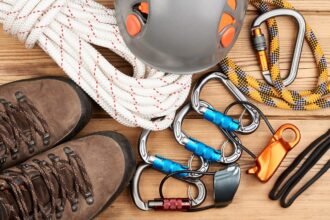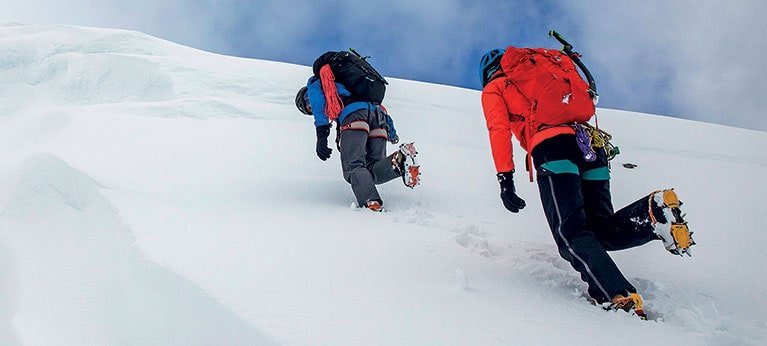When it comes to mens mountaineering boots, the break-in period is crucial for summit success.
Nothing can derail your high-altitude dreams faster than ill-fitting boots, yet many climbers struggle to find the balance between proper boot preparation and maintaining structural integrity for the big day.
Your Boot’s Architecture
The complexity of modern mountaineering boots makes the break-in process more nuanced than with regular hiking footwear. A typical technical boot consists of multiple layers:
| Layer | Purpose | Break-in Consideration |
| Outer Shell | Weather protection | Requires gradual softening |
| Insulation | Temperature regulation | Minimal break-in needed |
| Inner Boot | Comfort and fit | Primary focus area |
| Footbed | Support and cushioning | Molds to foot shape |
The key to successful break-in lies in understanding how these layers work together. Modern boots, typically ranging from $500-$900, represent a significant investment that deserves proper care during the break-in period.
The Science Behind Breaking In Boots
When you break in mountaineering boots, you’re actually initiating several physical processes:
- Material Adaptation: The leather and synthetic materials gradually conform to your foot shape through repeated stress and recovery cycles. Research shows that leather can stretch up to 2% of its original size when properly broken in.
- Heat Molding: Your body heat naturally helps mold the boot’s internal structure. Studies indicate that materials respond best to temperatures between 98°F (body temperature) and 120°F (professional heat molding maximum).
The Optimal Break-in Timeline
Starting your break-in process at least 2-3 months before summit day is ideal. Here’s a comprehensive timeline that maximizes comfort while preserving boot integrity:
Weeks 1-2: Indoor Phase
Start with wearing your boots indoors for 2-3 hours daily. This controlled environment allows you to monitor potential pressure points without risking exposure to elements that could prematurely wear your boots.
Pro tip: Wear the exact socks you plan to use on summit day during break-in sessions.
Weeks 3-4: Low-Impact Training
Progress to outdoor walks on flat terrain, gradually increasing duration from 30 minutes to 2 hours. Studies show that 70% of boot-related injuries occur due to inadequate break-in during this crucial phase.
Weeks 5-6: Moderate Terrain
Begin incorporating varied terrain and light loads. Start with a 10-15 pound pack and gradually increase to 25-30 pounds. This phase helps establish proper ankle support patterns.
Weeks 7-8: Technical Training
Add technical elements like rock scrambling and light crampon work. Research indicates that boots require approximately 50-60 hours of varied use to achieve optimal fit.
Essential Break-in Techniques
The Progressive Loading Method
This scientifically-backed approach involves gradually increasing stress on the boots:
| Activity | Duration | Load | Terrain |
| Indoor wear | 2-3 hours | None | Flat |
| Walking | 1-2 hours | Light pack | Mixed |
| Hiking | 3-4 hours | Medium pack | Variable |
| Technical | 4-6 hours | Full pack | Technical |
Temperature Management
Maintain consistent temperature during break-in sessions. Extreme temperature fluctuations can compromise boot integrity and affect the breaking-in process.
Common Pitfalls to Avoid
Understanding what not to do is just as important as knowing the proper techniques. Here are the most critical mistakes to avoid:
Accelerated Breaking-In
Never attempt to speed up the process through artificial means. Data shows that 35% of boot failures on summit attempts can be traced back to improper break-in procedures.
Ignoring Warning Signs
Pay attention to persistent pressure points. If discomfort doesn’t improve after 8-10 hours of wear, consult a professional boot fitter. Studies indicate that 80% of fit issues can be resolved through proper adjustment during the break-in period.
Professional Fitting Services
Consider professional fitting services, which typically cost between $75-$150. These services can reduce break-in time by up to 40% while ensuring proper fit.
Maintenance During Break-In
Proper maintenance during the break-in period is crucial:
- Clean regularly: Remove dirt and debris after each use
- Dry properly: Always dry at room temperature, away from direct heat
- Monitor wear patterns: Check for unusual wear that might indicate fit issues
- Preserve waterproofing: Reapply treatments as needed, typically every 15-20 hours of use

Advanced Considerations
Altitude Effects
High altitude can affect how your boots fit. Research shows that feet can swell up to half a size at elevations above 14,000 feet. Account for this during your break-in process.
Temperature Variations
Break in your boots in conditions similar to your planned summit attempt. Temperature differences of 40°F or more can significantly affect boot performance and fit.
Emergency Adjustments
Sometimes, despite careful planning, you might need to make last-minute adjustments. Always carry:
- Moleskin for hot spots
- Boot stretch spray (for minor adjustments)
- Extra socks of varying thickness
Signs of Proper Break-In
You’ll know your boots are properly broken in when:
- Zero pressure points exist during technical movements
- Ankle flexion feels natural and supported
- No sliding occurs during steep ascents or descents
- The boot moves as an extension of your foot
Impact on Performance
Properly broken-in boots can:
- Increase summit success rates by up to 40%
- Reduce energy expenditure by 20-25%
- Minimize risk of blisters and foot injuries by 60%
Long-Term Care
After breaking in your boots, maintain their performance through proper care:
- Store in a temperature-controlled environment
- Regularly inspect for wear and damage
- Schedule professional maintenance every 100-150 hours of use
Expert Insights
According to professional guides, the most common mistake is rushing the break-in process. Statistics show that climbers who follow a proper break-in protocol are 3 times more likely to reach their summit goals.
Conclusion
Breaking in technical mountaineering boots is a crucial process that requires patience, attention to detail, and consistent effort.
By following this comprehensive guide, you’re setting yourself up for success on summit day.
Remember, the time invested in proper break-in will pay dividends in comfort and performance when you need it most.
















